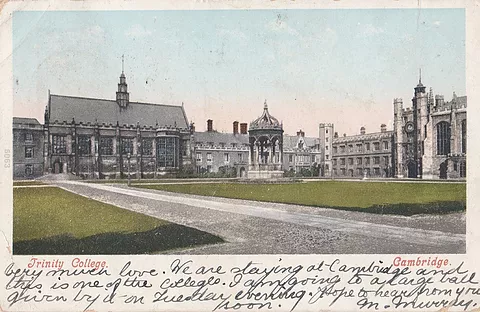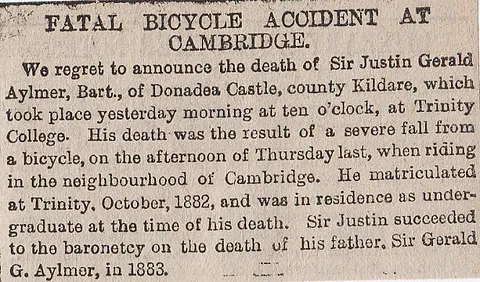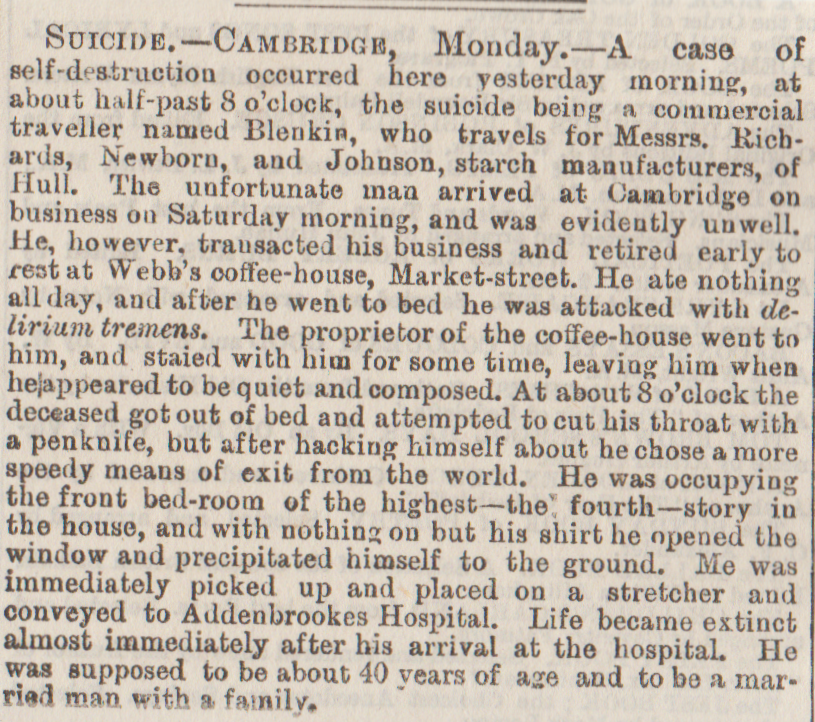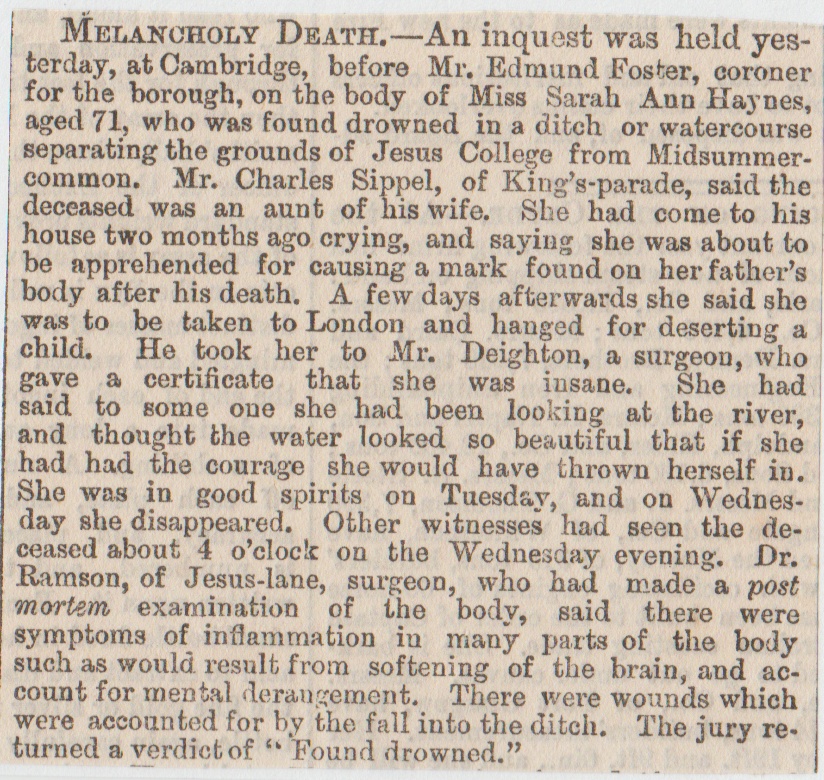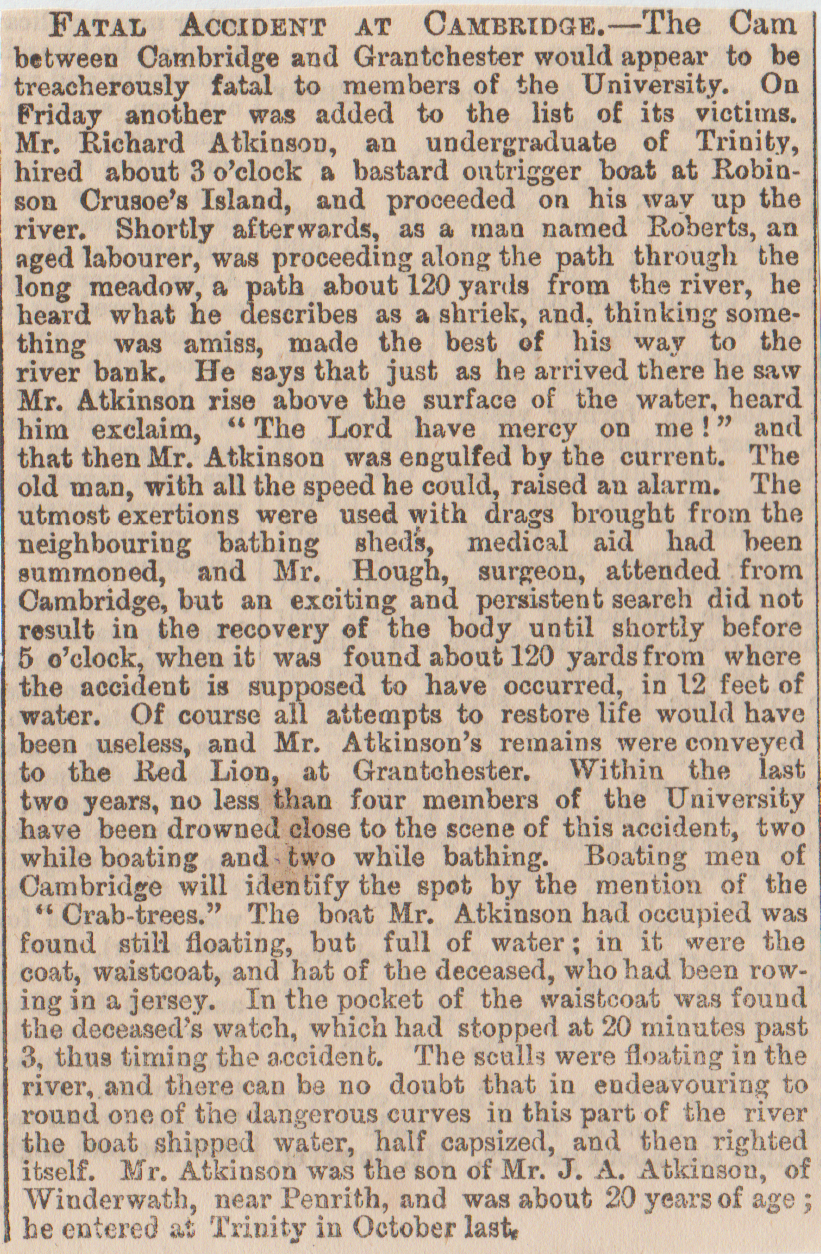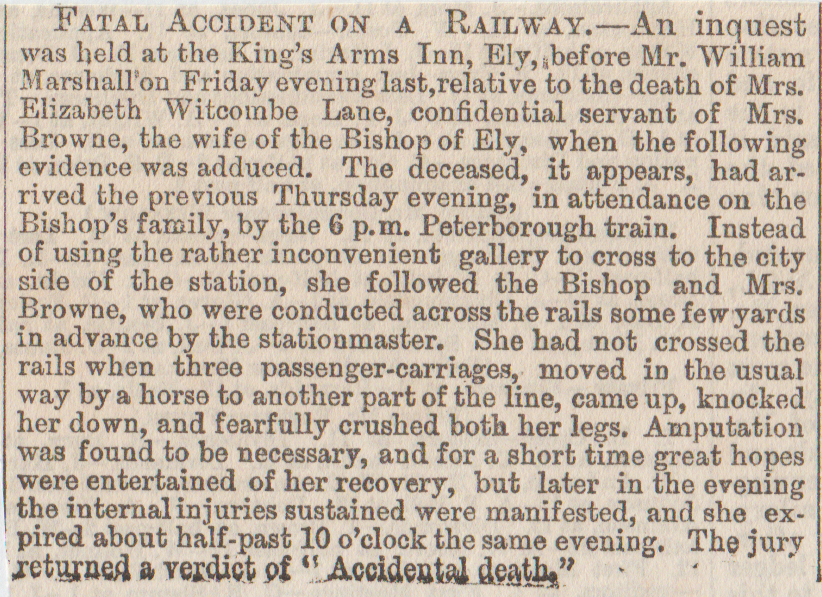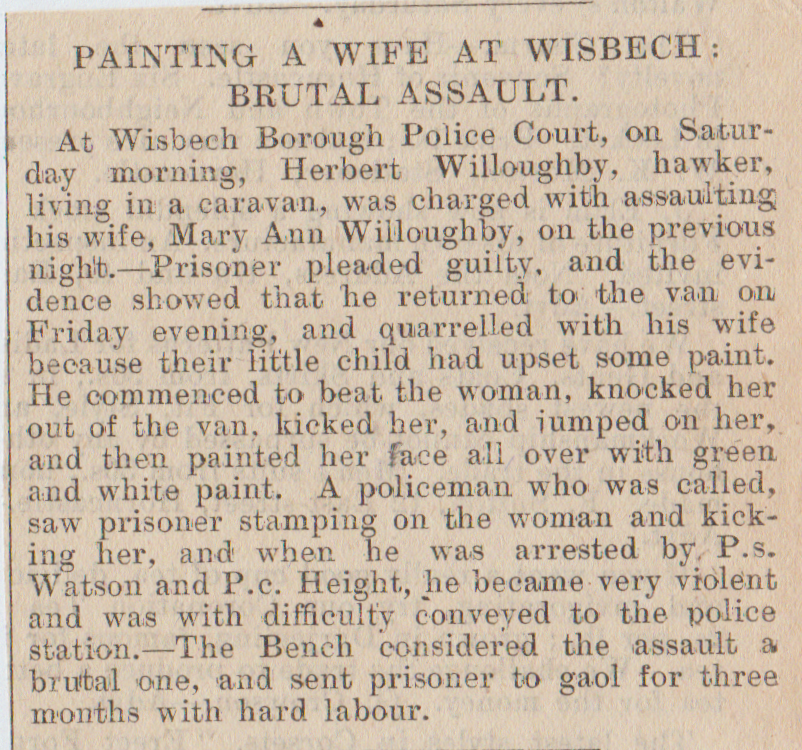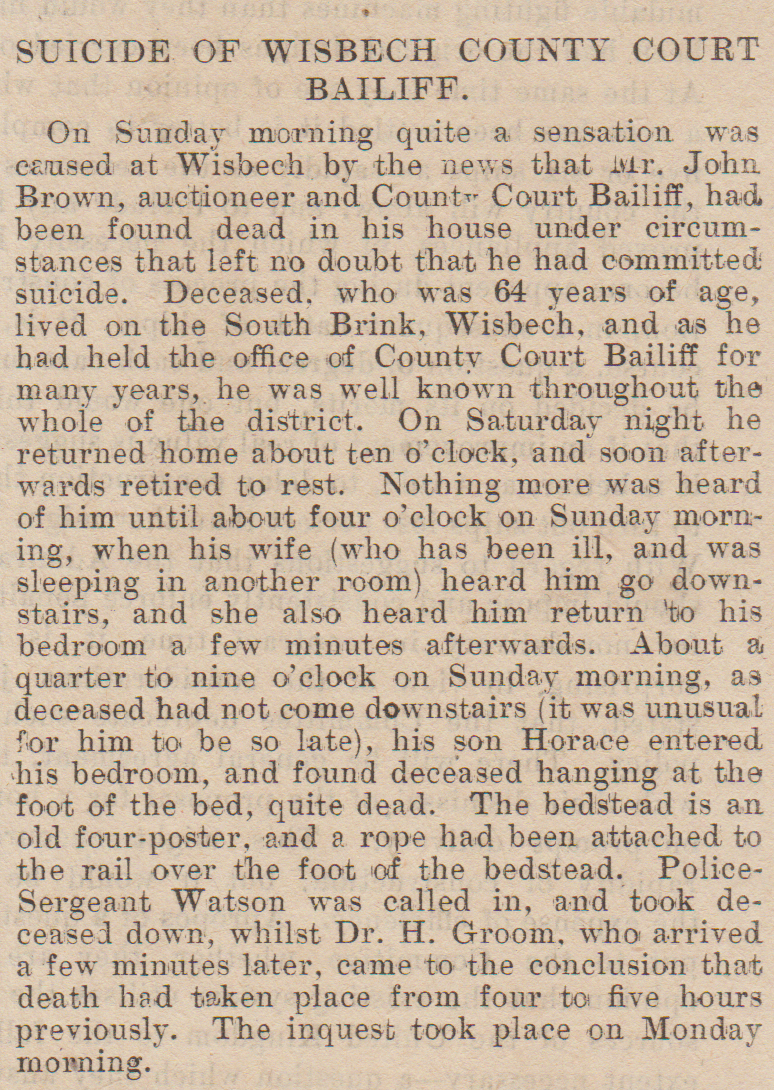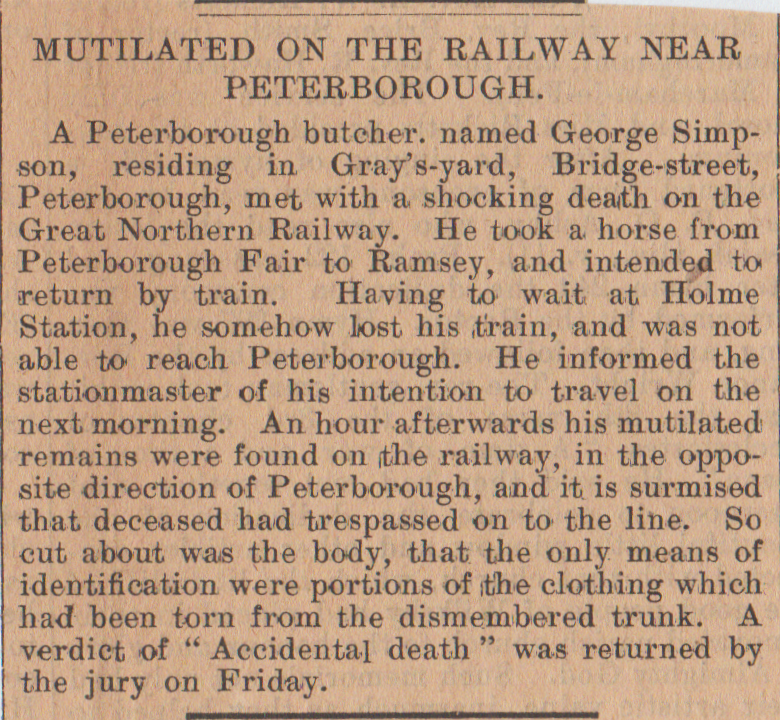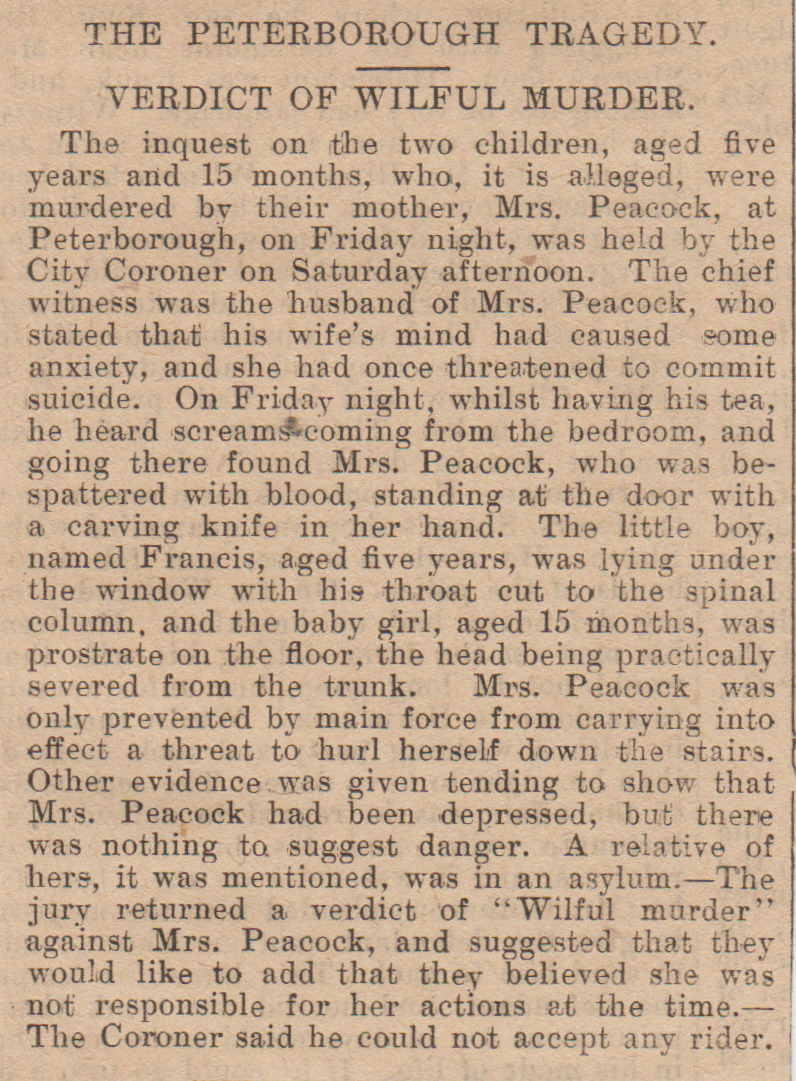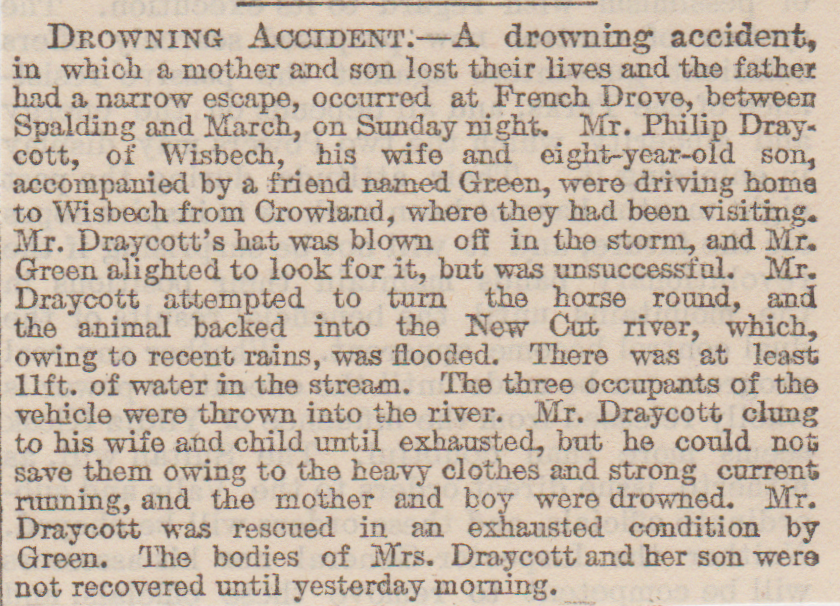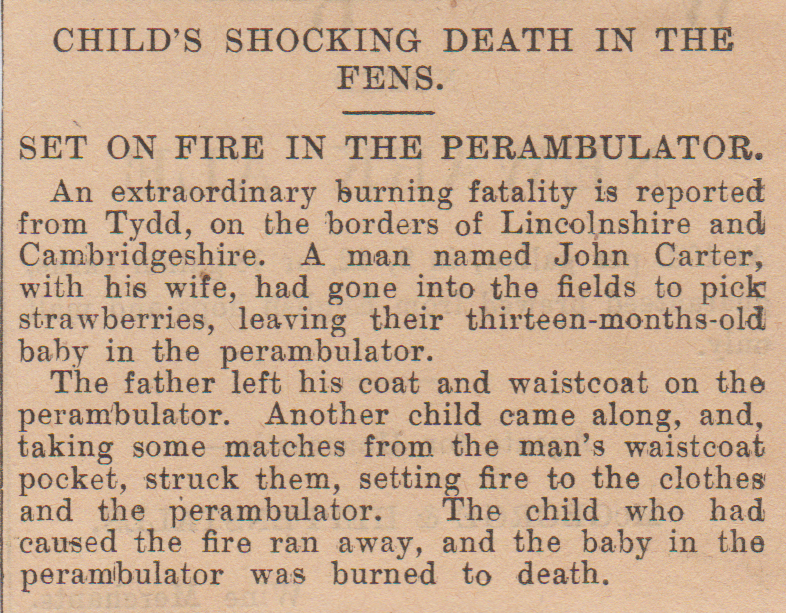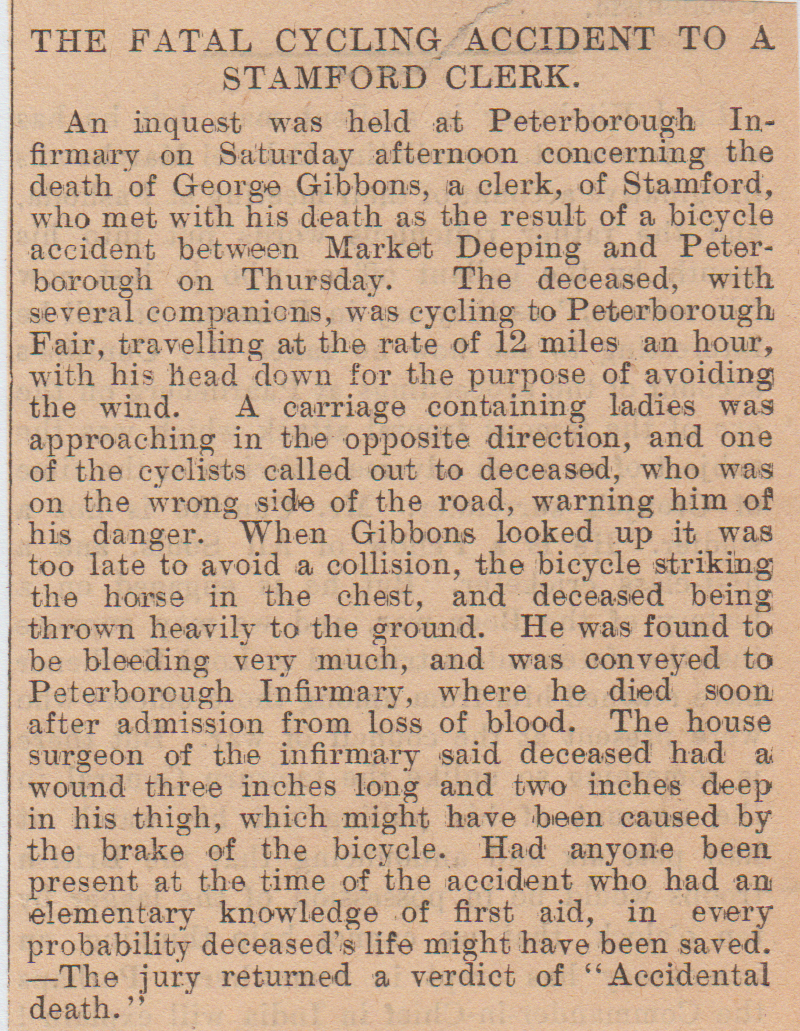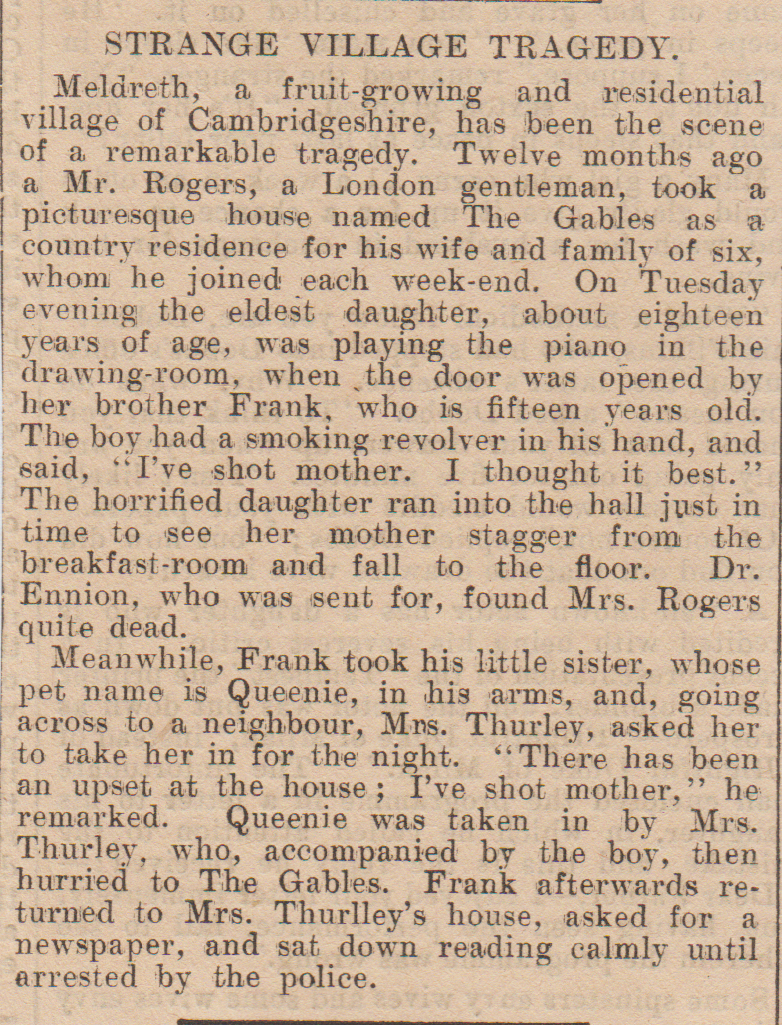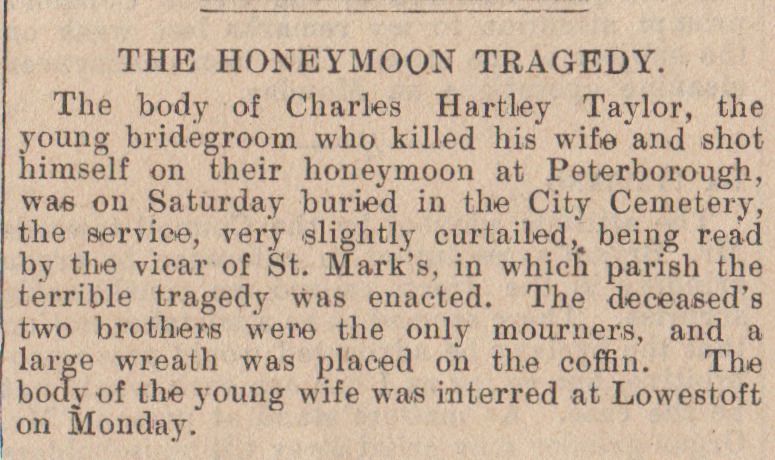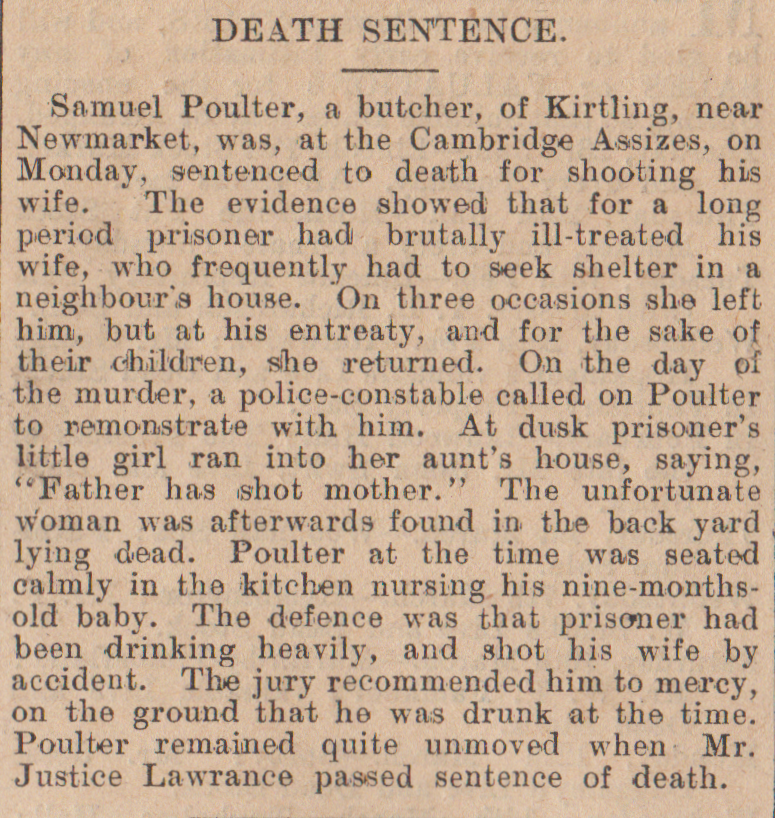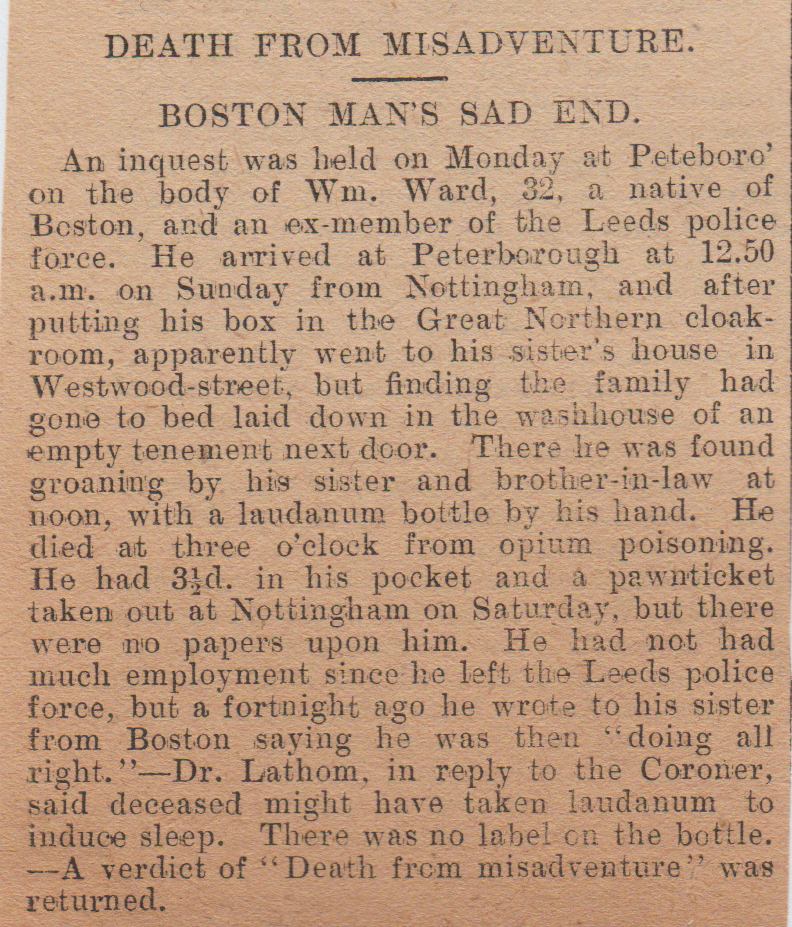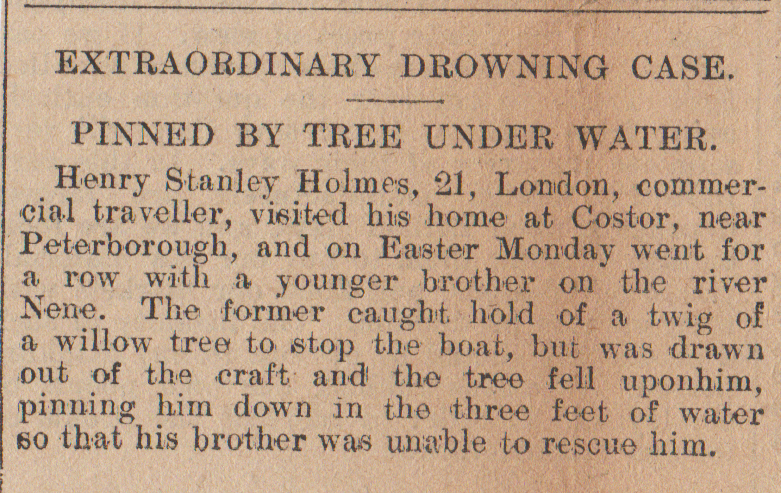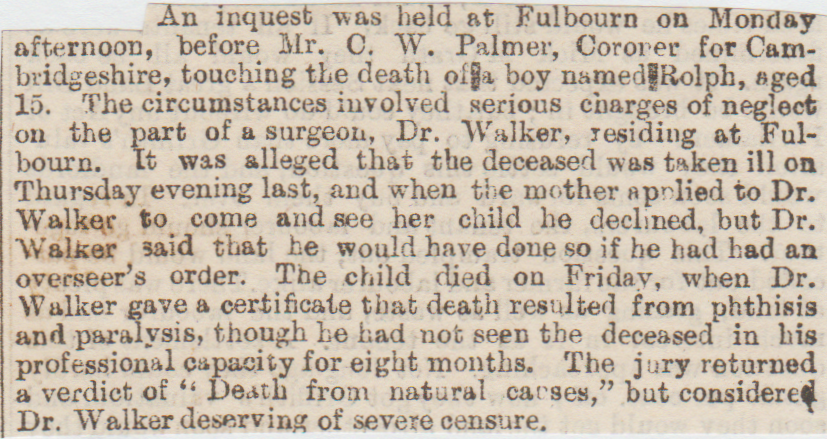1/ Wimblington near March, February 1896 (Quadruple murder/suicide)
Mary Jane Farnham and her four children had not been seen by her parents for a number of days, so they sent a couple of her brothers to find out where she was. They got the help of P.C. Lee, and entered the cottage through a window and immediately found the four-year-old and eleven-year-old with their throats cut. They were in their night-clothes, and this suggests they were in bed asleep while mummy dearest had slit their throats. In the bedroom, an identical scene presented itself. A little girl of three, and a boy of eight, also had their throats slit, with Mrs Farnham’s head was resting on the three-year-old’s body, with the knife in the neck and the entire scene a blood-bath. Apparently, she was a good mother with no financial or psychological problems so the reason for this rash act is unclear.
2/ Cambridge, Trinity College Suicide, May 1891
Arthur Edward Ellis was found dead in his room at Trinity College from a self-inflicted gunshot wound. The gun was next to his lifeless body, and it is thought that the pressure of an exam due in a few days was the reason for lad’s self-destruction.
3/ Huntingdon, Cambridgeshire, January/February 1867
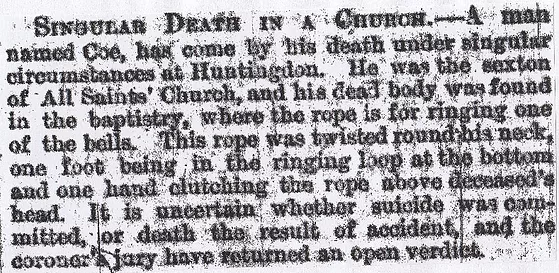
4/ Ely Cathedral Death, April 1901
A Justice of the Peace from Burnley, Lancashire, Mr.John Butterworth, expired in Ely Cathedral, probably from a heart attack as he suffered from heart disease.
Butterworth was on his way to Cromer for a break and stopped off in Ely for a little look around. He had lunch at the train station then made his way up to the cathedral. He entered and was taking in the painted ceiling when he keeled over. He was 64 years old, which in Victorian times was a cracking age.
5/ Kimbolton Church Suicide, Cambridgeshire, October 1887
Thomas Chattell, 44, a parish clerk from Catworth attended an Oddfellows meeting at the Black Swan Inn. Straight after this, he walked into the church and never came out. Mrs.Chattell realized her husband was still not back from the night before and conducted a search party, when lo and behold they found him in the pew where he did his duties as a parish clerk. He had slashed his throat with a razor.
6/ Peterborough Railway Station Death, September 1887
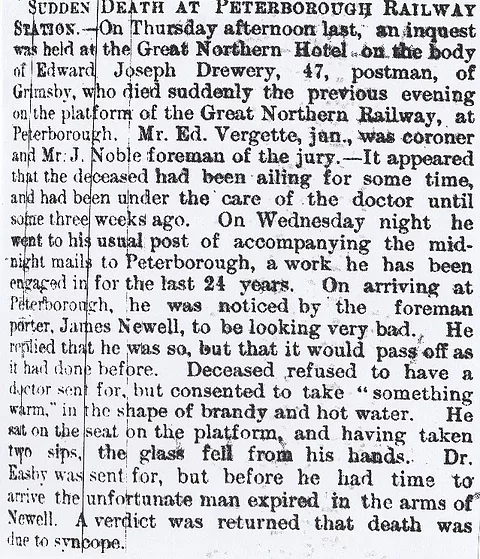
7/ Clare College Suicide, Cambridge, May 1849 (Suicide)
Edward Hayman, sizar of Clare Hall, was found with his throat cut, and a suicide note next to him, covered in blood, read;-
“Goodbye, father.Thank you, dear Henry, for—“. He hailed from Somerset and was 21, and by all accounts, he was a promising student. Hayman made two efforts at suicide, the first being on a high desk nearby, which was covered in blood as well, then wrote the note and went to his bedroom for a second try, which succeeded.
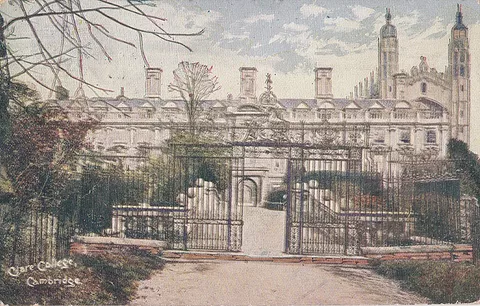 8/ Catherine Hall Suicide, Cambridge, October 1840
8/ Catherine Hall Suicide, Cambridge, October 1840
An undergraduate named Hofman, 25 years of age, had failed in a couple of exams. This was all too much, so he took some poison and ended it all in his room.
9/ Tydd St Giles, December 1900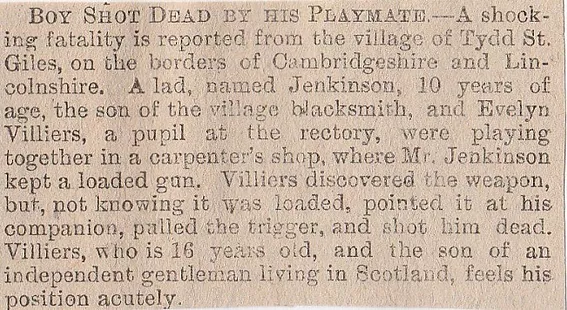
10/ Whittlesey, July 1895 (Scythe Attack)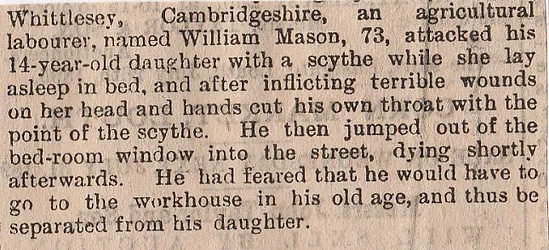
11/ March, Cambridgeshire April 1851
Mr Edward Miller, a brewer, discovered that two of his servants had been pinching his flour so he asked them about it and they admitted it, so he let them off, as long as they didn’t do it again. Next day the two girls and another servant of Miller’s sister went missing at the same time. They were found in a field, one of them was dead. At the inquest, it was said they bought three lots of laudanum in different chemists, so they could commit a suicide pact together. They all went to the field, lay down, and took their poison. Two of the girls vomited theirs up but Mary Ann Sutton swallowed hers and died from the effects. Sarah Archer said she took it so she wouldn’t be laughed at and derided for her stealing. Sarah Ann Roberts said she did it because Sutton and she were “partners” and she loved her so much, that she would rather die than be without her. The law states that if two people tried to commit suicide and one succeeded and the other survived then that person was guilty of aiding and abetting a murder. (Charged with murder?).
12/ Peterborough Suicide, August 20th, 1885

Peterborough Suicide, August 25th, 1885
13/ Cambridge Fatality, March 1885
14/ Melbourn, Cambridgeshire, May 1852
A weird accident happened at Melbourn in Cambridgeshire.Some kids were playing, and one was dragging a wash-trough on wheels, and in it was an infant of 16 months, Emily Dearman.A horse and cart were coming down the road when a child saw it coming, left it in the middle of the road, with Emily in it, and the horse trod on her head, literally squashing her brains out.
15/ Peterborough Drownings, June 1899
Two cases of drowning are reported from Peterborough. A little girl named James lost her life while paddling in the River Nene, and a man named Tatham was drowned while bathing a disused clay-pit.
16/ Stapleford, January 1899 (Vicars Strange Will)

17/ Hinxton near Cambridge, November 1905 (Child ground in Mill)
A terrible accident happened at Hinxton near Cambridge when John Tabor was left outside the mill shed for a little while. The father, who worked at the mill, heard a grinding noise, and when he ran to the spot he saw his son being ground up under the mill-stone. He was terribly mangled and died a nasty death.
18/ Ely, Cambridgeshire, August 1892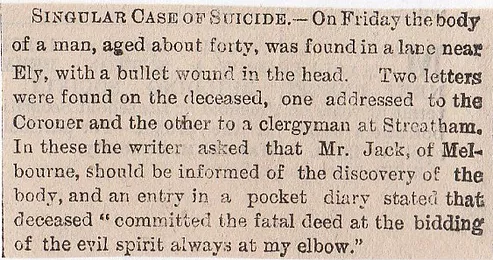
19/ Peterborough Cathedral Suicide November 1889
Because of the sexton’s suicide in Peterborough Cathedral, it has been raised that it will have to be re-consecrated. The matter came before the chapter and the clerk and it was mentioned that there was no statute or law making it compulsory. (What was done?)
20/ Cambridge Murder, March 1890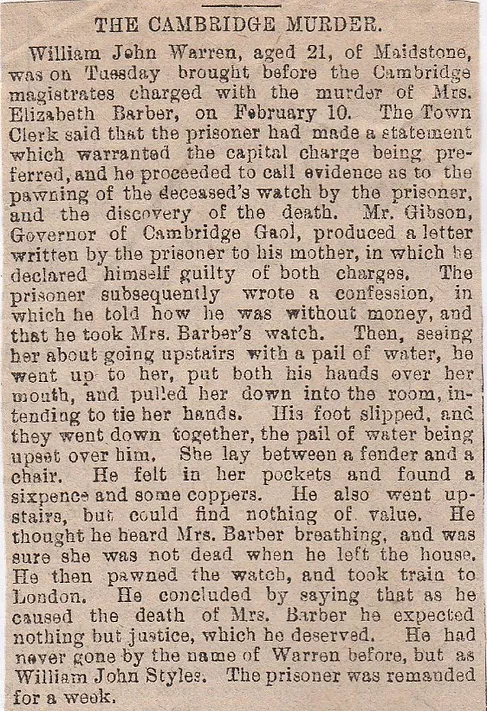
21/ Cambridge, August 1879
A woman was convicted at a court in Cambridge of illegally pawning. After the court appearance, she told her daughter to remove a basket at her house. The girl went to her home, but opened it, and saw to her horror, a dead child packed in lime.
22/ St Neots, Cambridgeshire, March 1899
23/ Peterborough, October 1908
An ex post-office employee, named Bunning, cut the throat of a widow named Hicks, then went to the River Nene, and threw himself in. She was not that badly injured and walked to Hospital. Bunning wanted her to marry him, but she fancied someone else.
24/ The Wash/The Nene, August 1892 (Boating Accident)
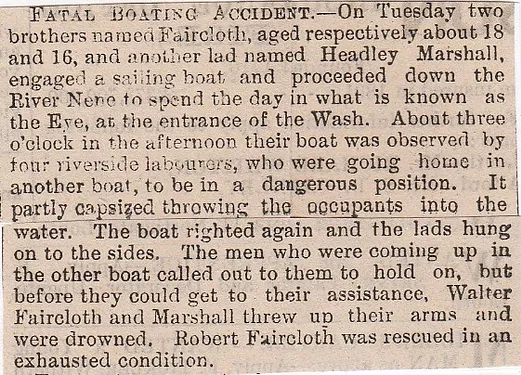
25/ Newmarket Road, Cambridge, November 1858
Susan Butler was with a friend in a fly (Two-wheeled gig?), and they had been drinking. While at an inn the two women were chatted up by a couple of blokes and they went with them in the trap. Butler wanted to drive despite her alcohol intake, she went off at a furious pace and this caused the trap to tip over, they were all throw out and Butler was killed. “Accidental Death” was the verdict, caused by the driver’s actions.
The two men, who were thrown clear, were two University graduates, and the tutor and master of the college attended the hearing, just to make sure.Money talks eh!
26/ Peterhouse College, Cambridge, June 1895
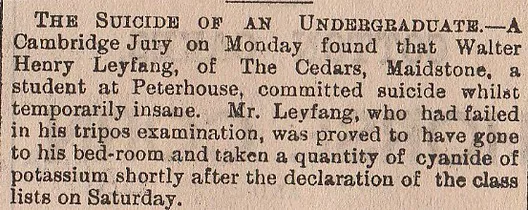
27/ Cherry Hinton near Cambridge, May 1873
Mrs Gregory, of Cambridge, was the widow of the Rev.James Charles Gregory, formerly of Canterbury. The lady was for the past two or three years, really depressed, especially in spring or autumn(Seasonal Affected Disorder), and for the last week or so she’d been especially bad. She went to a brook in Cherry Hinton, after she posted a letter to her sister stating that she could endure life no longer. She was 51 years old and leaves six orphans, and the verdict accordingly was “Temporary Insanity”.
28/ Nunton Crossing, Helpston, August 1866

29/ Huntingdon Execution, November 1878
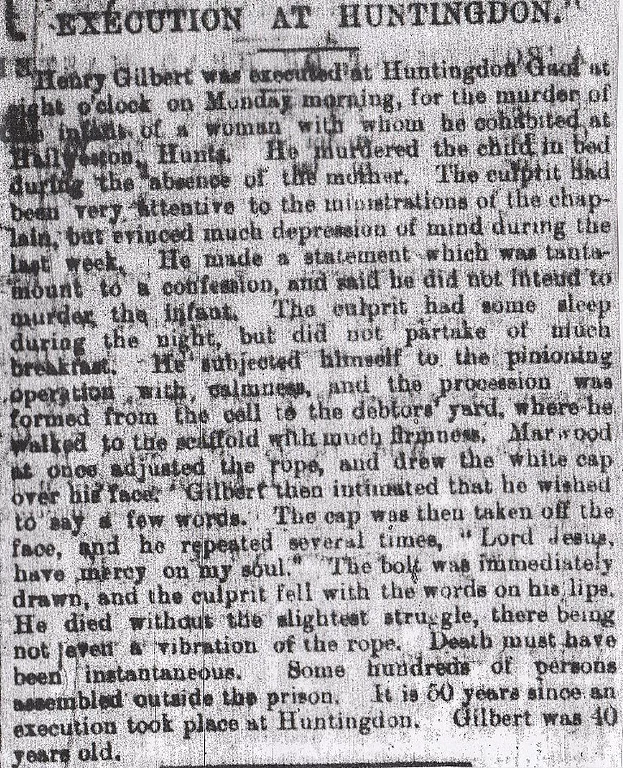
30/ Woodstone, Cambridgeshire, November 1861
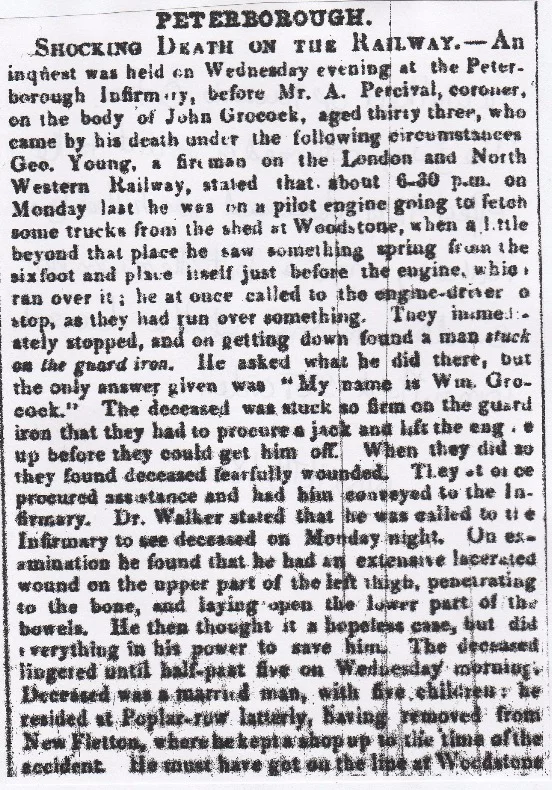
31/ Parson Drove, Wisbech, December 1879

32/ Parson Drove Murder, August 1861

33/ Huntingdon Station Suicide, June 1887
A baker from Huntingdon committed suicide by leaping in front of the Leeds Express which was passing through Huntingdon Station. The young man, now identified as Pettit, stood on the platform of the Great Northern Station and just as it was passing, he jumped in front, the train carrying him some distance away, and mutilating his body.
34/ Easton, Cambridgeshire, March 1860 (Double Suicide)
An elderly couple, named Saddington, both in their 70’s, and having lived in Easton for many years, were found drowned in a pond opposite their cottage dressed only in the nightclothes. The local bobby was on his beat and heard a scream at 11 o’clock, and he eventually found the two bodies floating in the pond. The possible reason for the double suicide was that these two had been to Huntingdon to the guardians for relief. That was turned down and they were told they could go to the Union Workhouse. This, they didn’t want, so it seems they jointly decided to drown themselves, but getting rid of furniture, paying debts and so on, first. The verdict was “Found Drowned”.
35/ Market St. Suicide, Cambridge. December 1870 (Webb’s Coffee House?)
36/ St Neots Railway Suicide, October 1870
On Saturday 15th October, a young man of respectable appearance, and apparently about twenty-two years old, committed suicide by placing himself on the metals (rails) of the Great Northern Railway in front of a heavy coal train, which passed over him, severing his head from his body, and otherwise mutilating him. Death was, of course, instantaneous. The scene of this determined self-murder was between St Neots and Sandy, about a mile and a quarter south of the former station. The time was about 9-45 a.m. The remains of the unfortunate young man, which it is, needless to say, were not at all recognisable, were promptly removed from the spot to await the coroner’s inquest.
37/ Body Found near Jesus College, January 1866.
38/ Fatal Accident on the River Cam, Grantchester. February 1866
39/ Ely Railway Station Fatality, November 1866 (Ely Station still looked a bit precarious when I last saw it. On Station Rd it is overgrown with weeds and very antiquated.)
40/ Little Abington Letter Bomb, December 1866 (An infernal machine is akin to a letter bomb, or a time bomb)
41/ Swavesey Murder/Suicide, June 1866
42/ Painting his Wife, Wisbech. April 1902.
43/ Wisbech Court Bailiff Suicide, May 1902. (South Brink)
44/ Death on the Railway, Holme Station. October 1902 (Holme is seven or eight miles from Peterborough)
45/ Murder of Two Children at Peterborough, July 1903
46/ French Drove Drownings, October 1903 (French Drove is a road. Literally, one end is in Cambridgeshire, the other in Lincolnshire, near Crowland)
47/ Killed by Lightning at Stechworth, September 1903. (At the bottom of the clipping, it should read ” Death was due to a visitation of God”)
48/ Baby Dies in Pram Fire, Tydd. July 1904.
49/ Fatal Cycling Accident near Peterborough, October 1904.
50/ Meldreth Murder, April 16th, 1904.
April 30th, 1904. Murder Charge against a Boy.
Frank Rodgers was committed for trial charged with the murder of his mother at Meldreth, on April 12th. Winifred Rodgers, sister of the accused, stated that on the night of the occurrence her mother was half asleep under the influence of drink. Her brother never complained to anyone of deceased’s drinking habits, which seemed to worry him a great deal. Accused was very fond of his mother, and they called him “Mother’s Boy”. He had been quiet and irritable lately and had complained of headaches. Dr Ennion said the lad told him on the night of the tragedy that a voice had distinctly told him to shoot his mother quickly, but he did not remember loading or firing the revolver. He also said that for two or three months he thought he saw his mother constantly behind him. When asked if he wanted to say anything by the Chairman, the prisoner shook his head and said: “No, sir”.
51/ Honeymoon Murder/Suicide, Peterborough. July 1905
52/ Woman Shot Dead in Kirtling, December 1905. (Accident or Deliberate?)
53/ Death Sentence for Wife Murderer, Kirtling. January 1906
54/ Westwood Street Suicide, Peterborough. January 1906.
55/ Young Man Drowned in River Nene., Castor. April 1907
56/ Ghost as a Will-Finder, Thorney Estate, near Peterborough. January 1907.
A farmhouse on the Duke of Bedford’s Thorney Estate, near Peterborough, has long had the reputation of being haunted by a lady in a red chintz dress, who, witnesses assert, always beckoned towards the ceiling of a certain bedroom. Investigation amongst the beams of the roof has now led to the discovery of the will of a farmer named Cave, who died at the farm over a century ago, leaving an estate of £10,000.

